
About Hellenistic Phalanx
From the early days of phalanx warfare under Philip II of Macedon to the second battle of Pydna, opposing Quintus Caecilius Metellus to King Andriscus in 148 BC, the Phalanx stayed at the forefront of ancient warfare. It was impossible to break front the front and presenting a constinuous front of sarissas was soon found capable of stopping and holding massive armies. The genius of Alexander the Great has been to use it as an anvil and cavalry as the hammer, used at the best moment and best place. An Empire stretching all the way back to India was conquered and successors for long kept the phalanx at the heart of their combined armies, even if the manpower needed dwindled back. The phalanx was still there, even after Ascepiodotos reforms in 143 BC, influencing both the Seleucid and Prolemaic armies.Apparently they still formed the solid core of the Egyptian armies under Antony and Cleopatra during the Roman civil war, although a more mobile infantry was now the norm. The phalanx was divided into multiple units generally called after their shields: As noted by ancient authors, the Leucaspidai had wooden (supposedly) parma shields painted white, the Chrysaspidai "golden" shields (most probably bronze polished that way), and the Argyraspidai "silver shields" were the famous elites of the Seleucid phalanx. To complicate more, the phalanx was also divided by experience, Alexander's pezhetairoi ("foot companions") being the veterans, and opposite the "phalangitai deuteroi", litt. levy phalanx. were the basic unexperience, poorly equipped troops that were raised among Hellenistic settlers along the Empire. It is fait to say they originated in the early Macedonian phalanx. But of course the best known of these phalanx units was the Chalkaspidai, or "bronze shields".
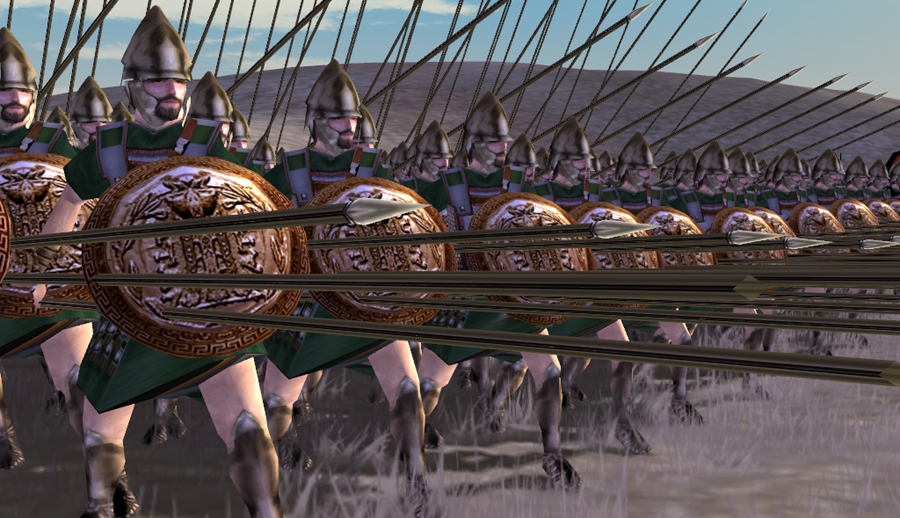
catw's rendition of a Epirote Pezhetairoi Chalkaspidai. Notice the konos helmet.
The classical Phalanx
Philip II probably never invented the phalanx, which was rather a reformed units co-invented by both the Theban general Epaminondas and the Athenian general Iphikrates. The long and protracted Pelopponesian war indeed served as an experimentation ground for many new units. Before it, warfare between city-states was heavily codified and almost bloodless, rather a sporting event than actual combat. Hoplites faced each others singing and later engaging in a melee, something which id generally best described as a "rugby pack with spears". Only the front ranks speared each others (or tried) but pressure alone was here to ake the other side crumble.When done, there were gestures of submissions, spear inverted, shields left in place, which generally ended the fight with a winner of some sort. Both sides then departed home, arriving in the evening due to the short distances involved and few flat terrains available between city-states for such show. The hoplitic formations has been seen as a "fight between equals", men from the upper democratic society, the only able to purchase this equipment, as well as landowners, rich merchants, etc. Fighting in the phalanx was part of being a citizen. However the Pelopponesian war (431–404 BC) started to change this "amateurism", leaning towards true, complex, unapologetic, total warfare.

catw's rendition of an Antigonid Chalkaspidai. Notice the Chacidian helmet.
The great reformers
The need for more professionalism made hoplitic phalanxes swapping equipments and tactics towards more efficiency. New helmets like the attic one, leaving more hearing and seeing in combat which superseded the old (very iconic) Corinthian model, lighter, more mobile hoplites like the Ekdromoi, chasing peltasts, even mounted hoplites like the aspidophoroi started to change the way warfare was made. Armies were much larger due to the use of hoplitic formations from allied cities, hired cavalry (mostly from Thessaly), mercenaries such as peltasts and peasant slingers and archers showed the transition to large pitch-battles with the goal to crush and rout the enemy.Iphikrates: This Athenian general was credited for making in the equipment of the peltasts or light-armed mercenaries sufficient to hold in a prolongated melee, facing hoplites, whereas this has been long impossible due to the very nature of the peltast, basically a light infantry, a skirmisher. There are also doubts over the fact he could have also reformed the mercenary hoplite as well, giving him a light equipment. The equipment consisted in a much light and smaller pelte compared to the heavy hoplon, boots instead of the traditional greaves, light armor, and a longer pike, four meters rather than three for the extra reach, and held by two hands, which was only possible by strapping the lighter pelte to the forearm, freeing the hand. This famous move gaive birth to the "Iphikratean hoplite" which was the direct ancestor of the Thureophoroi, the first true greek medium infantry of the IVth Century.
The equipment was completed by reforms in discipline, drill and maneuvers; Mercenaries ("Mistophoroi") were already noted professionals, they were now engaged in more mobile and agressive manoeuvers, double pace or even running to their opponents. Iphikrates demonstrated th value of these reforms in a superb show in 392/390 BC at the Battle of Lechaeum. There, before Epaminondas twenty years after, he almost annihilated a mora (a Spartan battalion of about 600 men). The Pelopponesians and the Achaian league later made great use of these units in several occasions. Although Philip did not knew him he certainly heard about the battle and reforms, later hiring veteran officers of his army to implement the same reforms.
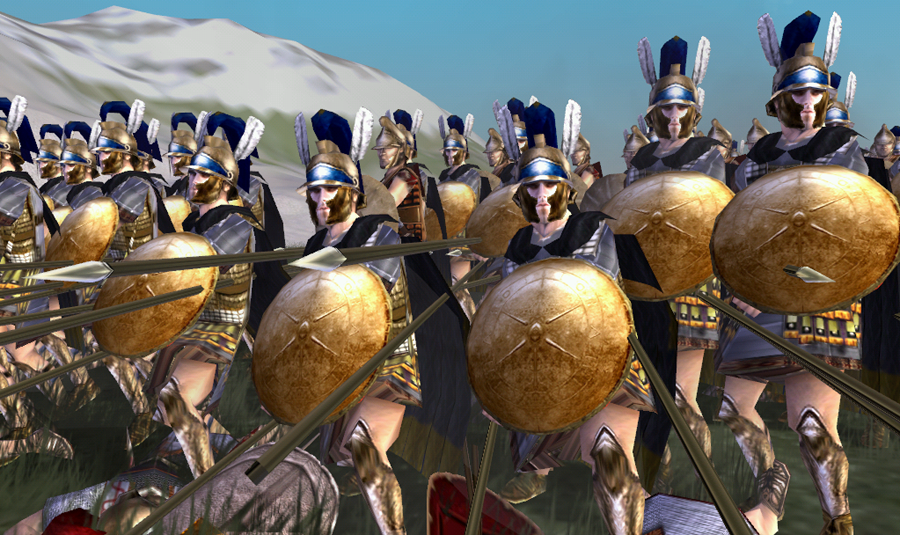
catw's rendition of a Pontic Chalkaspidai. Notice the Thracian helmet.
Epaminondas (Ἐπαμεινώνδας) was a Theban general and statesman which unique reform proved decisive at the Battle of Leuctra, in 371 BC. There, the Thebans were able to crush a Spartan mora (batallion). The Spartans were reputed the best army in the world at that time, for good reasons. However they were not known as great innovators. The Theban general famously saw the natural tendency to the hoplites veer to the right during battle, "because fear makes each man do his best to shelter his unarmed side with the shield of the man next him on the right". He knew for this reasons the Spartans would muster their elite hoplites at the right, headed by Cleombrotus. Facing the three other "mora" made of Spartans and their allies, he threw "standard" hoplitic formations which only goal was to engage and "fix" the enemy. Meanwhile he placed in front of the elite Spartans the best troops in the army, and arranged them 50 ranks deep (as opposed to the normal 8–12 ranks) on the left wing.
He placed Pelopidas and the famous sacred band together with a much deeper unit than the one already experimented (with some success) by Pagondas, another Theban general (25 man deep formation) at the Battle of Delium. He reversed the usual order and used for the first time the "oblique order" designed to turn an army completely in order to eventually start to surround the next wing and provoke a total collapse (which happened there). The oblique order became a famous tactic also applied with the same success over millenias by Prussian statesman Frederick the great.
The other espect noted was that strengthened Theban left flank marched to attack at double speed rather than the usual way. This was made to augment pressure even more. The other theban units were hard-pressed and even gave way, but when the Spartan broke and fled, so did their allies, ending woth a total, crushing victory. At Leuctra, the Spartans left perhaps 500 men on the ground, quite a dent in its limited manpower. This ended Spartan dominance and saw the rise of Theban Hegemony. As noted by Richard A. Gabriel, his tactics "marked the beginning of the end of traditional Greek methods of war".
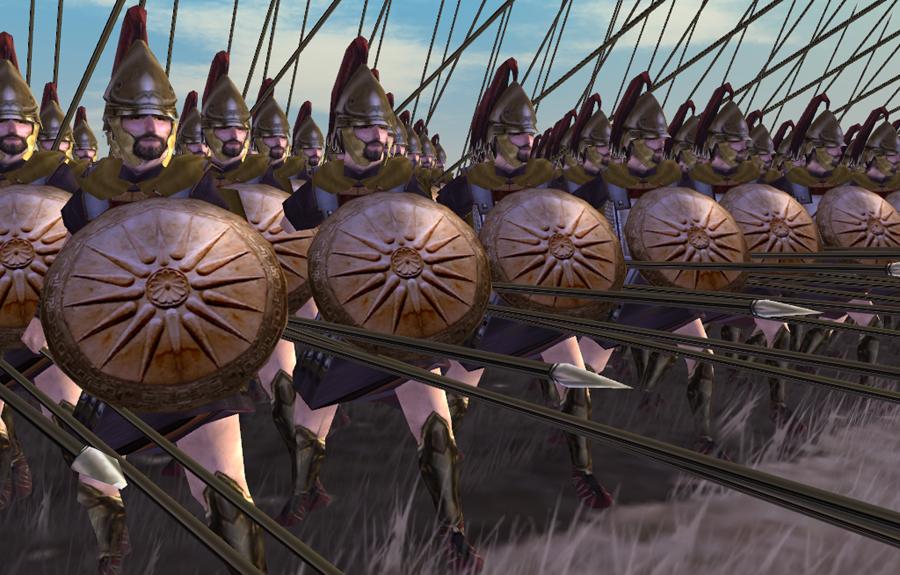
catw's rendition of a Katoikoi Chalkapidai (rich settler phalanx). Notice the konos helmet variant.
Epaminondas reform greatly impressed young Philip (Future king of Macedon), an hostage in Thebes, as he marvelled before the precision and professionalism of the Theban army, in total contrast with the tribal-like nature of Macedonian warfare at that time. No doubt it was a driving force for him when he created his own form of phalanx.
Philip's reforms and Hellenistic warfare
Philip II of Macedon combined both sets of reforms to create what is called today the "Macedonian phalanx". Rather than hoplites, few in numbers from the only capital of these lands, Larissa, he developed a peasant-based professional infantry modelled after the lightly equipped Iphikrateans, mustered into a massive formation of 256 men, not 50 or 25 ranks deep but more reasonably 16. However to compensate this inferiority he gave them eve longer spears, five meters rather than four. When the first ranks lowered their sarissas, this formed an impenetrable wall of pikes. Not only nobody could pass it and reach them, but when marching, none can resist this force frontally. There were weaknesses in these formations though: If the crucial right flank was generally protected by a mobile, elite formation (such as the Somatophylakes or Royal Peltasts), the rear was not.More often in Hellenistic times these were held by reserve troops, weak levies such as the "pandotapoi", preventing by their mass and presence a swoop from an enemy infantry or cavalry. The other weakness was archery. Macedonian phalangites were lighty armored compared to hoplites, easy preys for arrows. Philip II generally had its most experienced, best equipped phalangites on the first eight ranks, keeping the lightly equipped, less experiences at the rear of the formation or Lochoi.
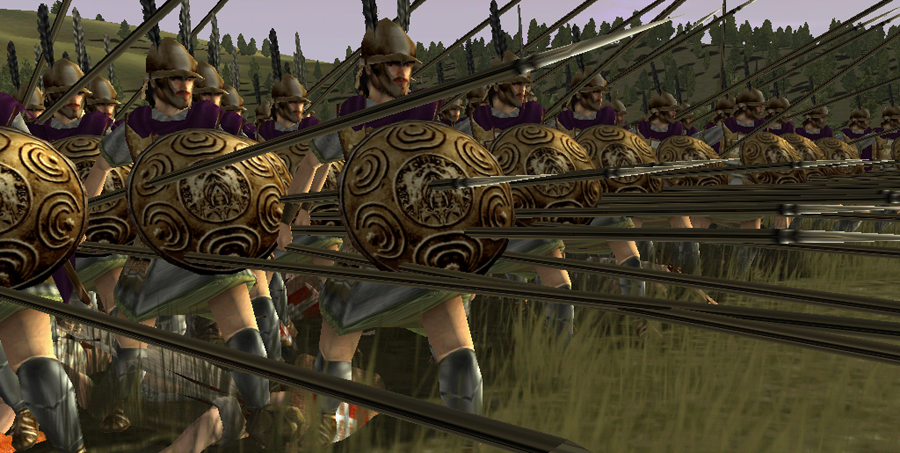
catw's rendition of a Macedonian Bottian phalanx, Chalkapidai. Notice the short konos/boeotian helmet variant.
With time however, veterans emerged and they were picked-up and massed together in specific elite units. They were given the best equipments available, making them heavier, closer to the traditional hoplites. Their sense of belonging and title was given by the authors by describing their shield. No longer a weak pelta, it was a reinforced parma, a round shield made in wood like a miniature hoplon. These shields were no longer one meter in diameter but rather 60 cm. They were thus often larger than the old pelte, heavier also, and reinforced with bronze plating like the hoplon. This fact led to three ways the shields were finished and polished, or decorated.
The Bronze could indeed look silver or gold depending on the case. However it seems the super-elite Argyraspides were genuinely given silver-plated shields. True silver and not treated bronze to look silver. The reason was they were forer Hypaspists, already elites, picked-up "shield bearer" equipped and fighting as hoplites rather than phalangists. This less disciplined, more individual approach was also to underline their status and merits. The "silver" would halso had a double-meaning, referring to the grey color of the men's hairs, mostly 40+ in age when in India under Alexander the Great. The prestige of this crack unit was such that the Roman Emperor Severus, centuries after, named two of his elite legions of 'argyroaspides' and 'Argyraspides';
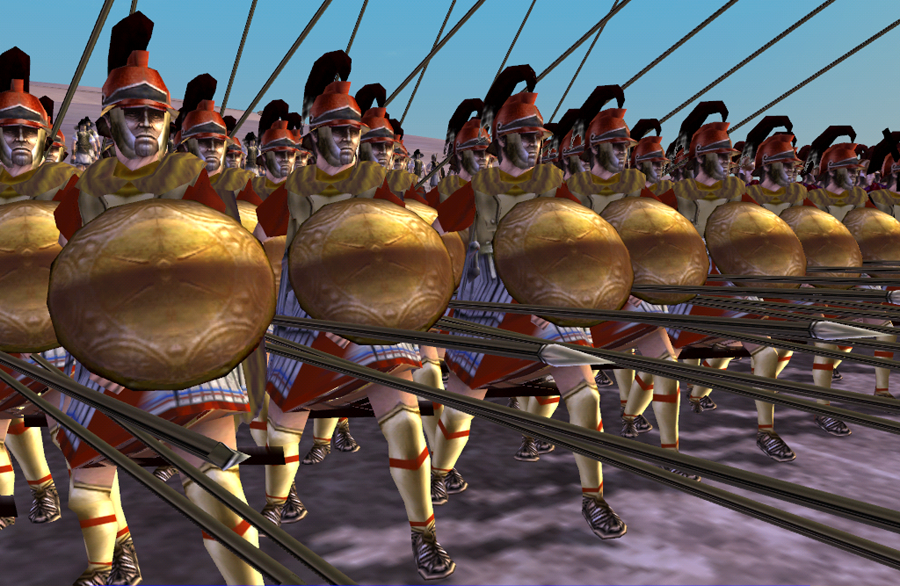
catw's rendition of a seleucid Chalkapidai. Notice the painted thracian helmet and long pteruges linothorax.
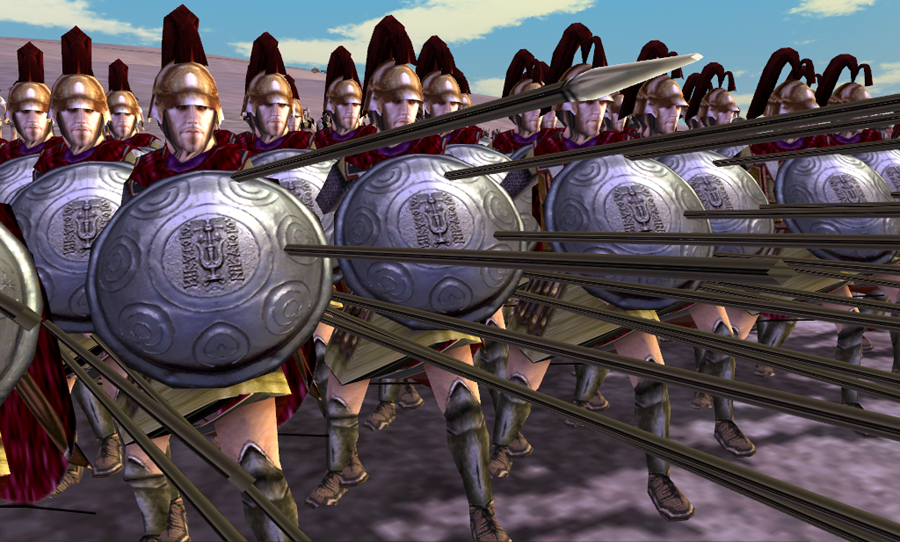
catw's rendition of the more famous seleucid Argyraspidai. Notice the Boeotian plumed helmet and composite armour.
The Chalkaspidai or Bronze shields
This long introduction was necessary to understand the status and rank of such unit, as decribed by ancient authors. The Χαλκάσπιδες or "Bronze Shields" were clearly described as having a bronze-plated parma. The bronze was probably left as is, not painted as generally done in many covered shields. They were first identified as one of the two elite corps of the Antigonid armies, the other one being the Lucaspidai (white shields) already described. However, Chalkaspides were found in other armies a well in the Hellenistic era. The truth is that they were probably around in many regular phalanxes since the Greek conquest (before Philip II assassination). Indeed as said above, the 16 or 24 front men of a traditional Lochoi (each line was a 16-men strong lochoi, the ensemble making a syntagmata) were either more experienced and/or better equipped, acting as "promachoi" (vanguards) in any Lochoi. This includes a composite linothorax, greaves, good helmet, and a bronze-plated parma.Elites could have wear these, but more probably the wealth of the plunder made on Greek hoplites could have provided the necessary covers from many hoplons, which were very often bronze-plated. So when Alexander started his Persian campaign, no doubt that the first ranks of most phalanx units were wielding a bronze-plated parma. Over time, it is well possible that veteran units could have been much better equipped, to the point of most of the men in each Lochoi and at least the first eight ranks were given bronze-plated shields. Although there is no mention of a particular unit before the deah of Alexander described as "chalkaspidai", the term appeared afterwards in Hellenistic times and is frequently associated with the elite status of a unit. In addition to the Antigonids, Chalkaspides are also named as part of the Seleucid, Pontic and Achaian armies. Each time they are assimilated to elites.

Equipment & tactics of the Chalkaspidai
Picking-up the cream of each Syntagma and sending them to coherent elite units, all composed by similarly-equipped men had some advantages. Firstly, these experienced men as a whole were less subjected to panich and flee when facing waves of enemy infantry. They were also much better protected against arrows, sling stones and javelins, including in the rear lochoi (ranks), making these units much more resilient. In a long battle line it could have been wise to interlock these with regular levies or mid-experienced Syntagmas, showing the example, and holding fast.Having several of such units could have allowed to reinforce the weaker right flank by the most veterans within Chalkaspides. We do have these units named, but not how precisely they fared in battle though. It is certain also that heavier bith by age and armour, they would likely be left out of any fast-paced action, like double-pace phalanx manoeuvers or charge. They increasing presence would have certainly slowed down the phalanx, and without the creative genius of Philip and Alexander or even the first Diadochi, the phalanx lost its ability for quick manoeuvers. War became more conservative and static. Morale and numbers alone started to make a difference rather than hardy or daring tactical moves.
Helmet:
The Chalkaspides were obviously better equipped than average phalangites. They would have been given all six items: Armament wise, a cornel wood pike, five, but most likely six meters in lenght. A kopis sword for close quarter (more on this later). And protection-wise, a helmet, a composite armour, greaves and or course a parma. This way, they were entirely protected from head to toe. The helmet diversity was quite amazing in the 3rd and second century BC. Even among these elites were known as "super elites" the so-called Asthetairoi. They were possibly city-dwelling northern Macedonian citizen chosen for their prestigious origin. Equipment-wise they would have been Chalkaspidai, but placed on the right side next to the Hypaspists and close to the king himself. They could have been the equivalent of early Chrysaspidai for the Antigonids. Chalkaspidai would have rather be wearing a late helmet, such as the Thracian model, or an the Chalcidian model. Both were sturdy and more utilitarian than the previous Corinthian helmet, not speaking of the totally obsolete "Illyrian" style with a square opening. The Thracian model was probably the heaviest and sturdiest of all. It was characterized by a thick rim over the top, like a stylized plume, could be agremented with feather-holding tubes, with the front reinforced by a long frontal rim, to protect the beare against sword slashes. This was completed by large, to very large check pieces. The original model even had full frontal ar
Chalkaspidai would have rather be wearing a late helmet, such as the Thracian model, or an the Chalcidian model. Both were sturdy and more utilitarian than the previous Corinthian helmet, not speaking of the totally obsolete "Illyrian" style with a square opening. The Thracian model was probably the heaviest and sturdiest of all. It was characterized by a thick rim over the top, like a stylized plume, could be agremented with feather-holding tubes, with the front reinforced by a long frontal rim, to protect the beare against sword slashes. This was completed by large, to very large check pieces. The original model even had full frontal articulated cheek pieces which were strapped to the lower part, well below the neck. These "facial" models were unmistackably related to their original Thracian origin. These ornamented masks which reproroduced a stylized face, complete with the beard, were likely used by Thracian elites. Numerous examples had been found over time. No doubt they were a popular feature given the excellent protection and fear factor they generated, especially for the front rank phalangists. Over time, simplified versions were made with prolongated cheek pieces going well down, but not orenamented nor making a mask in front of the bearer. The Thracian helmet became so popular it was reintroduced during the renaissance as the burgonet, as well as the phalanx tactic alongside arquebusiers.
 The older, cheaper Chalcidian model was rounder, protected at the front by a rim like the Roman Imperial era Spangenhelm but still hugely popular. Like the Thracian model, there was a cut for the ears, so giving an excellent hearing, as well well protecting articulated cheek pieces. Decoration would have comprised old-fashioned horse crests but also plumes and feathers, and ornamented figures for some fanciers, noble piece of equipments. These were seen as modernized version of the Corinthian model. To note also, a rarer model, but quite popular in Italy was the apulo-Corinthain model used by early Roman hoplites and Triarii. They were stylized versions of a Corinthian helmet lifted upwards and completed by articulated cheek pieces. Also very popular, if not the most overused, was the Attic helmet, an evolution of the Chalcidian model, simpler. It was adopted by the Romans later, especially within the cavalry and elites.
The older, cheaper Chalcidian model was rounder, protected at the front by a rim like the Roman Imperial era Spangenhelm but still hugely popular. Like the Thracian model, there was a cut for the ears, so giving an excellent hearing, as well well protecting articulated cheek pieces. Decoration would have comprised old-fashioned horse crests but also plumes and feathers, and ornamented figures for some fanciers, noble piece of equipments. These were seen as modernized version of the Corinthian model. To note also, a rarer model, but quite popular in Italy was the apulo-Corinthain model used by early Roman hoplites and Triarii. They were stylized versions of a Corinthian helmet lifted upwards and completed by articulated cheek pieces. Also very popular, if not the most overused, was the Attic helmet, an evolution of the Chalcidian model, simpler. It was adopted by the Romans later, especially within the cavalry and elites.
Older but still very, very popular models included the other "thracian" model, more often called phrygian helmet, as it emulated the traditional phrygian cap wore by asia minor populations. The great height make the wearer even more impressive, especially when adorned with crests, plumes and feathers, as most probably officers (Syntagmatai) wore, painted and decorated in vivid colors. Rarer, and more likely reserved to lower-class phalangists would have been simple conical helmets (Konos), stylized versions of the peloponesian cap or Pyleus. They were especially popular among Antigonid phalangists. Some (also used by the cavalry) were shaped as a tall bowler hat, adorned with plumes and feathers. Much simpler were the Illyrian-style Kegelhelm, a simple bronze cone, short and wide. The lightest but also most stylish of all would have been cavalry-reserved Boeotian helmet. Their unique shape derived from the way they were formed, when the metal was still hot, hammered on a round stone surrounded by metal studs.
ARMOUR:
Body protection included three elements: The main armour, which could be either a linothorax, a simpler paddled armor, or a bronze anamorphic one. The other elements were the bracers for the forearms, usually in leather but in rare cases made in bronze, and the greaves, or tibia-protecting gear which sensibly were wrapped around the lower leg, strapped at the back. In that case, the wearer did not wore boots like the "iphikratid" or the thracian foxskin model but a simple sandal; The days of bare-footed hoplites were long gone. The linothorax was purposedly made in linen, and designed to replace the much heavier and not flexible bronze armor traditionaly used by the hoplites. The core idea was to regain mobility. Linen was cheap and light, so these armours, made with dozens upeon dozens of layers glued together made in practice the first composite armour in history.As shown by tests, they could stop an arrow head, a javelin spear tip and a slingshot. However they would bulge and be pierced by a vigorous spearpoint thrust, although absorbing much of the damage. These armour could seems ideal, but they were enormously complex and long to manufacture, and therefore were only given to the best of the best, likely Chalkaspides. In general, linothorax were composites. Part were made in linen, but also part with hardened leather, much cheaper, and scale armor, especially on the belly and along the side strappings, under the arms, traditional weak points. The wearer's back was usually reinforced as well as the shoulder by additional parts; The latter to stop sword slashes, the second to offer extra protection against high-flying arrows.

The less fortunate rear-line phalangists of the early phalanx probably did not had any body armor at all, or a paddled one, or a leather armor, way cheaper. The paddled armor seemed to have been adopted by Iphrikratean hoplites and leather ones were popular with the thureophoroi. Bronze armor was also more often used in time as phalanx tactics went down and more basic. The loss of mobility allowed heavier armour to be worn. Contrary to popular opinion, bronze armour in the 3rd Century were not costly items. Since they were considered obsolete, they were often second to third hand pieces of equipments. Most greek phalangists could have inherit these from their ancestors fighting in the phalanx. of course modern anamorphic ones could have been manufactured as well by able craftsmen. But they were mostly reserved to officers and horsemen. They could have been made very light and still reltively flexible due to the use of lateral strappings. Classic linothorax always included a flexible protection of the groin, replacing the very old articulated bronze pieces or archaic hoplites. The pteryges. These simple straps made in leather ended the lower part of the armour, circling the wearer's waist and going down to partly protect the thigh. The latter was also considered a weak point and often hit in battle. Based on this and the elite status of the Chalkaspides, we can safely assumed Linothorax were used in majority, especially in the front ranks. What about scale armour and mail armour for Chalkaspides ? It's only possible with very late ones units such as Pontic chalkaspides, especially if they were romanized infantry and not a phalanx.
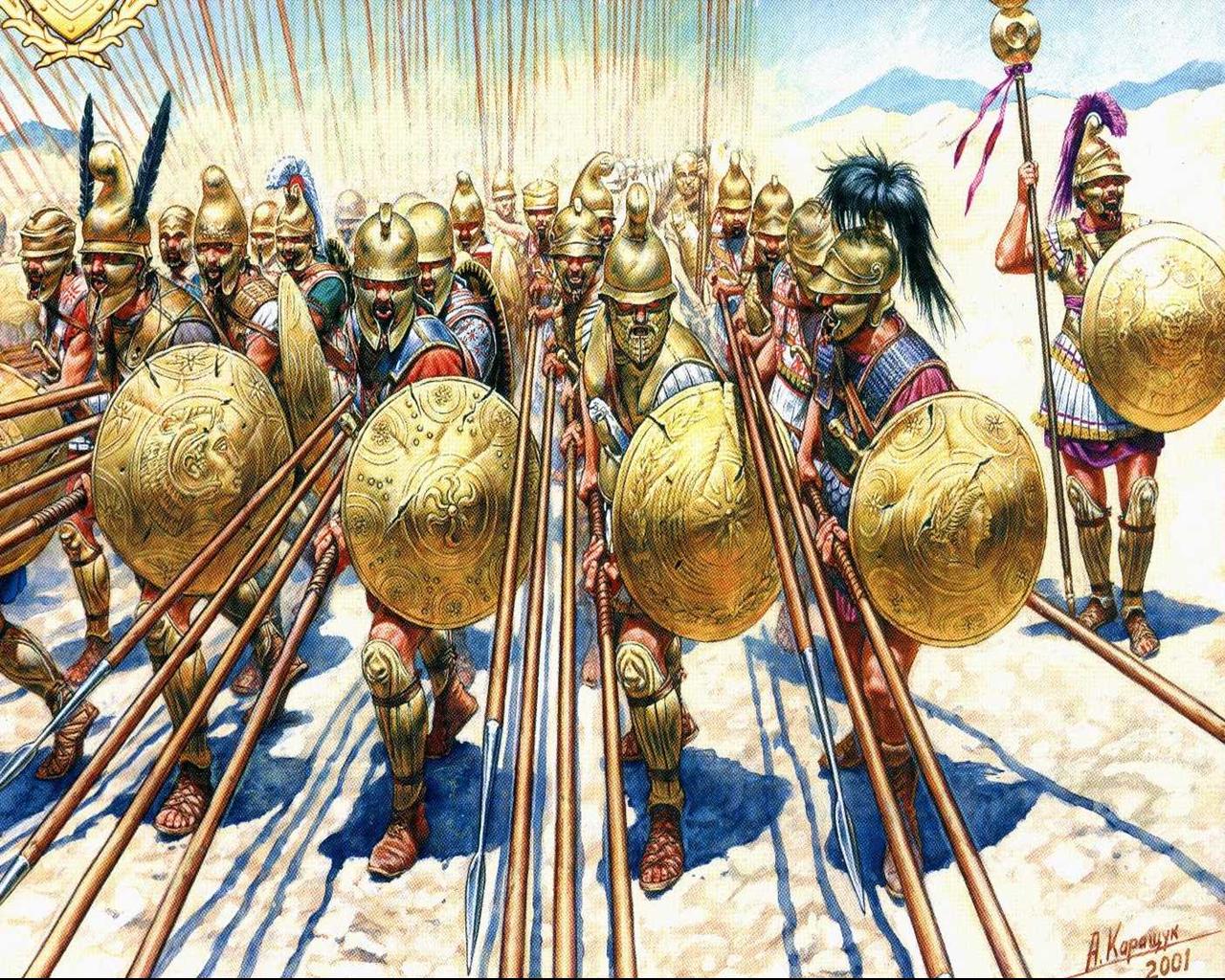
The other important part of armour was less close to the body: The parma. It could be seen as a scaled-down version of the aspis (or Hoplon), the traditonal one meter diameter hoplite shield. This was a composite shield, with a wooden circle shaped as a bowl, a reinforced central section often backed with leather, linen or more probably bronze, covered again by leather or linen to protect the metal from corrosion and being able to paint the shield. The parma was strapped on the wearer's forearm, replacing the armband or bracer placed on the other arm of the wearer. This extended protection also played a part by stopping arrows and spearpoints, acting as a spaced armor. The parma was used in a variety of ways, but the size was a logical choice in order to free the other hand, allowing to carry a double-handed spear. 60 cm seems very large to cover a forearm, therefor the shield also covered the hand almost totally, and the shoulder of the bearer as well. They were rarely used by swordsmen and hyspaspists which preferred the aspis, having no trouble using a single-handed spear or sword.
However they could have been used by peltasts and archers, including the pontic elites such as the thyreopherontes (in alternative to the thureos) and the famous Cretan archers, having the same advantage of freeing both hands to load arrows and handling the bow. They could have also been used by peltast cavaly such as the tarentines, as more handy than the aspis. The aspidophoroi were mostly understand as melee cavalry. The bronze-face Parma could have been painted, but it is not likely so, as to allow the commander to see this unit and distinguishing it from other ones on the battlefield. It is unlikely bronze-only parma could have been used in battle, due to the unnecessary weight on the forearm. Such bronze-faced parma were lilely used however in a particular episode of Alexander's conquest of remote fortresses of the ancient Bactrians (now Afghanistan), having his phalangists wielding their parma over them in order to leave the chariots run above them without arm when thrown at them from higher up as a tactic. A weak, wooden or even wicker parma or pelte would certainly not have allowed this tactic, but sturdy bronze-faced ones more so. Therefore it is safe to assume Chalkaspidai were used to assault these eagle's nests by day whereas hyspaspitai acted as commandos by night, climbing rocks with their aspis strapped on their back.
Armament:
The armament of Chalkaspidai was no different from the rest of the phalanx: A two-handed sarissa and a sword. The first was a cornel-wood five to six meters long spear, double ended with spearpoints. The main one was the forward-facing spear point, the second was at the back extremity, smaller. Its purpose was triple: Acting as a balancing weight in some ways, be used as a secondary spearpoint if the sarissa was broken, and be planted in the ground to hold off a charge in static mod, with the front ranks nailing. Indeed their "X" shape was quite singular. There is no desciption ever of such tactic, though. The sarissa were quite long and possibly assembled in two parts, carried strapped together at the back of the wearer and assembled for the battle. With two 2.50 m long pieces they would have been easier to carry. This is aso mostly conjectural as no wooden body of a sarissa ever survived, only spearpoints, nor any description was found. The six meters sarissa is likely a Diadiochoi-era invention. As stated above, the late hellenistic period saw a more conversative, static approach to the phalanx, and longer sarissas could have made a difference on the battlefield.The choice of Cornel wood was only deduced by remnants of wooden DNA found in spearpoints. It makes sense as the mos sensible for sturdiness and flexibility at the same time, but made the whole sarissa quite heavy, from 5.5 kg (12 lb) to 6.5 kg (14 lb). Combining such weight and lenght would have made it a poor close-quarter weapon by any margin. Only the massed effect of the phalanx justified it. The numerous fights over Syria between seleucids and Ptolemaic culinating with the battle of Raphia, saw the use of sarissas as long as 6.75 m (22.1 ft). However these ideas were eventually abandoned in favor of the battle-tried Philippine-Alexandrian sarissa, relying more on tactics than lenght.
In any case, when marching, the phalanx used to keep the sarissa vertical, leaving space between men in open order; When approaching the enemy, the formation closed ranks, enough for the shields to touch each other (but not overlap). Sarissas of the first ranks were then lowered at regular angles from forwards ranks to the middle of the formation. It was said that this "forest" of sarissas formed above the units an extra protection against falling arrows but it has never been proved. Only some computer calculation could give a clues about it. The closest real life experiment ever to this was the epic movie "Alexander the great" by Oliver Stone.
The sword now: Only carried as a "backup" it could have been absent of most early rear phalangites in Philip's era. Two types were carried, the common kopis, a slashing sword similar to the falcata (which probably derived from it) and the straight Xiphos. The latter could be quite long, but was essentially a thrusting, double-eged sword. There is no report on how were used these weapons in battle and comparisons, but in case two phalanx units were so heavily engaged and intermingled they could no longer use their sarissa, either broken or blocked by the other side, swords were drawn for close quarters. The second use was an accidental one, in case a phalanx unit was surprise-attacked, not having time to pick up their sarissa and form, as a close sidearm. Chalkaspides probably would have the best manufactured Kopis and Xiphos available, but there is no more clues as how they could have been used differently from regualr phalangists.

Late Seleucid Chalkaspidai
The majority of the late Seleucid phalanx was probably formed by the two corps mentioned in the Daphne Parade of 166 BC: 10,000 Chrysaspides ("Golden Shields") and 5,000 Chalkaspides. Little else is known but their probable presence at the battle of Beth Zachariah in 162 BC. Earlier, Antigonus Doson armed the citizens of Megalopolis with Bronze Shields for the Sellasia campaign in 222 BC. These shields were most probably spoils of war.Mentioned by classical writers and associated with the Antigonid army in battle, they probably ceased to exist after the battle of Pydna in 168 BC, with the dsappearance of the Antigonid kingdom and mainland greek independance. The Antigonid or Achaean phalanx used them, but also Pontus, as told by Plutarch about the composition of Mithridates VI of Pontus. Indeed he was probably the last to present a corps of 'Chalkaspides' against Sulla at the Battle of Chaeronea. This could have been the very last deployment of a phalanx, but these could have been also more mobile, modernized Roman-style infantry using bronze-plated thureos instead. After all, the late Seleucid "Argyraspides" were thorakitai with silver-plated shields. A romanized infantry and certainly not a phalanx.
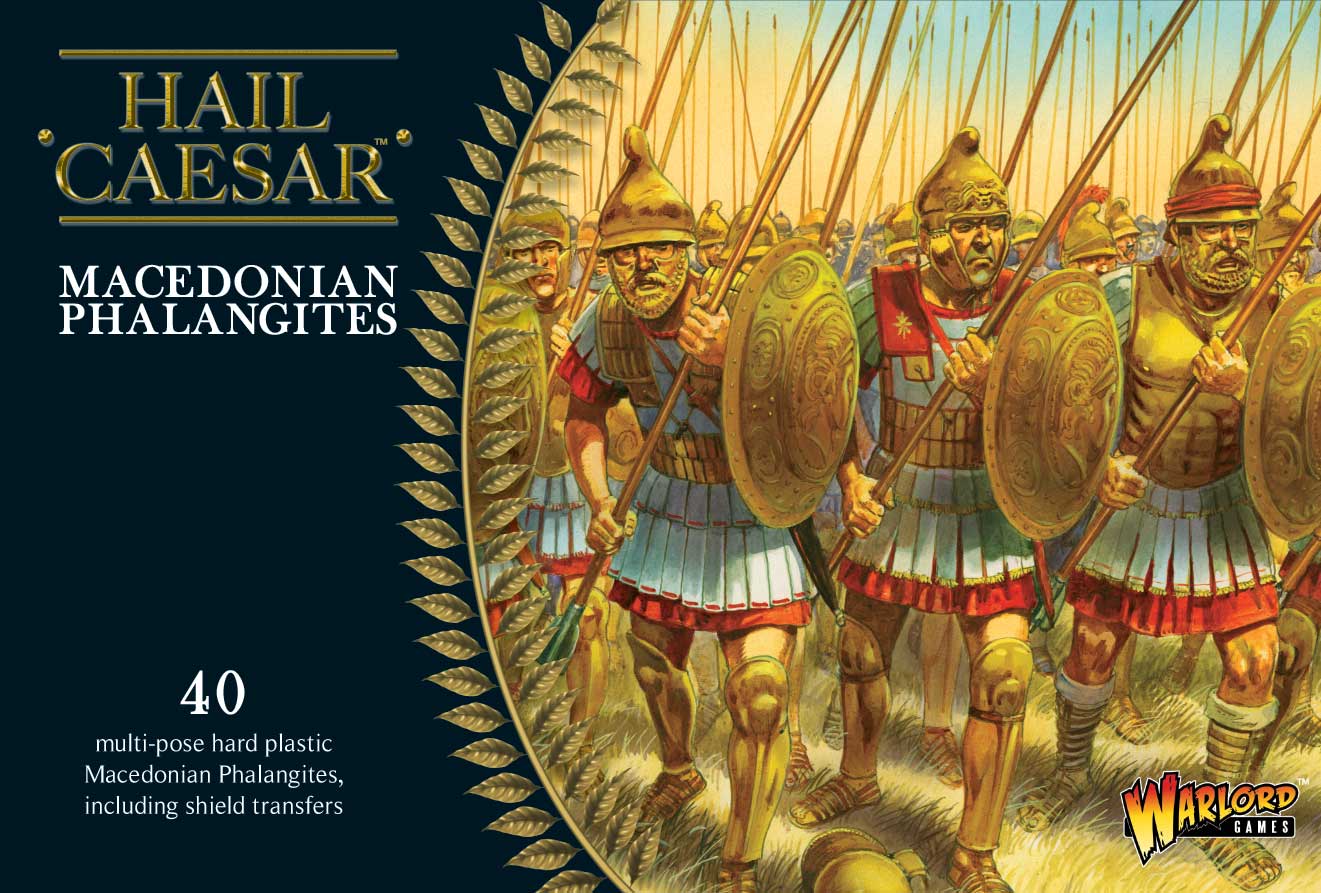
Tactic-wise, defeats of the phalanx in the hands of the Romans was mostly due to a degradation in the understanding on how such units must be protected. The failure to protect adequately the phalanx at Pydna by an inexperienced and possibly overconfident king Perseus largely explain the defeat. despite if this, even the Romans were impressed, even awe-struck by the simple sight of a phalanx manoeuvering, like Fabius which lived and fought in Greece during these last wars. Facing the legion, a phalanx was just unstoppable. Like any other form of infantry, hastati and principes would have to get between tighly closed bunch of spearpoints to get to sword range, and more likely used their pila.
Roman infantry was subdivided in smaller units and were mobile on all terrain, while a phalanx could be disrupted by it and easily turned and flanked. Protecting phalanxes with cavalry and light-armed troops indeed seems to disappear. As it was signalled earlier, the idea of a phalanx was resurrected during the renaissance in what was called the "pikeman". Combining massive pike units with more mobile arquebusiers was a combination made in heaven, ruling the battlefield for over two centuries. But pikemen of that time had no shield at all, or a small buckler. Nevertheless, a movie like "Captain Alatriste" showing at the end a pike melee is a good way to appreciate how hellenistic battles could turn ugly, and light troops tactics creeping below and through these pikes would have acted.
Sources/Read More
wikipedia's chalkaspidesOn totalwar.org
Formidable fighters Hellenistic
Hellenistic armies
Legion versus Phalanx: The Epic Struggle for Infantry Supremacy in the Med (Google book)
Greek Phalanx - history.net
Plutarch. Aemilius Paullus, c. 20, Sulla, c. 16 & c. 19
Sekunda, Nick (2001), "Hellenistic Infantry Reform in the 160's BC"
♕ Aquitani & Vasci ♕ Celts ♕ Indo-greeks ♕ Veneti ♕ Yuezhi ♕ Indians ♕ Etruscans ♕ Numidians ♕ Samnites ♕ Judaean ♕ Ancient Chinese ♕ Corsico-Sardinians
⚔ Cingetos ⚔ Immortals ⚔ Cavaros ⚔ Cataphract ⚔ Romphaiorioi ⚔ Chalkaspidai ⚔ Devotio Warrior ⚔ Scythian Horse archer ⚔ The Ambactos ⚔ Iberian warfare ⚔ Illyrian warriors ⚔ Germanic spearmen ⚔ Carthaginian Hoplite ⚔ Thracian Peltast ⚔ Caetrati ⚔ Ensiferi ⚔ Hippakontistai ⚔ Hastati ⚔ Gaesatae ⚔ Cretan Archer ⚔ Thorakitai ⚔ Soldurii ⚔ Iphikrates ⚔ Kardaka ⚔ The thureophoroi